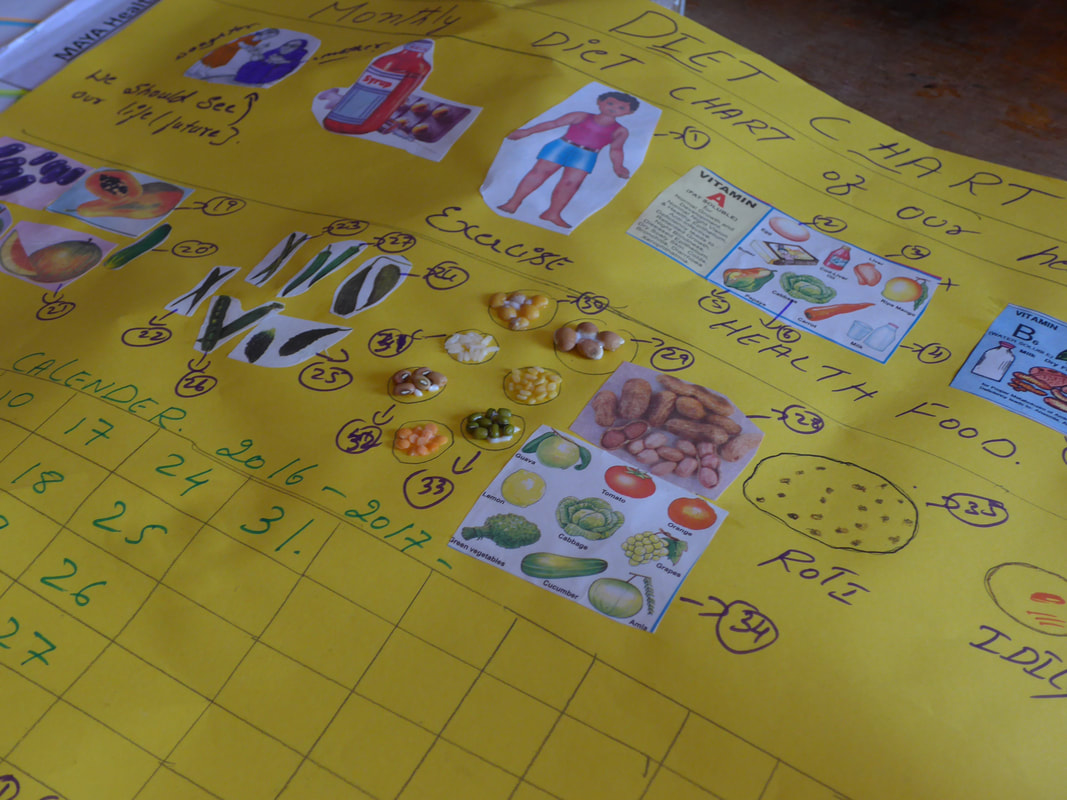|
I contributed to this project as a facilitator, together with Naveen Bagalkot and in collaboration with Maya Health, an NGO that works with a group of health workers in Channapatna, Karnataka. The initiative where our project is located supports the ecosystem of workers as a channel to improve the overall health status of the villages. Part of this support includes providing the women with tablets. The objective of including design thinking and creative pedagogies, is to understand how technology can be part of their routines beyond playing a purely utilitarian role. At the end of the project we created a series of design tools that women can use in the future, and we identified the opportunity to work with dietary charts for the local use in the villages. The design process, creative participation, co-creation: The theoretical starting point of this intervention is participatory design. How can we, along with the community, think about the design of technologies, as opposed to: How can technologies be designed so that they can be used by communities. The first meetings were opportunities for the participants and this group of women to become familiar with each other. Visual exercises such as sharing daily routines were spaces to build trust. The second phase included exercises to find opportunities for intervention. This group of women provide advice to people in their community, going to their homes and manually recording data such as blood pressure, sugar levels and eating habits, among others. We carried out many exercises with them, aiming to recreate the different moments where they work and coexist, in order to identify their relationships with customers and moments where there is a need, which is not necessarily technological, but in terms of the amount of information necessary for the workers to make decisions that are favourable for the patient and immediate during their meeting. After having a set of opportunities identified, we conducted an ideation session where we prototyped technology with low cost materials and we also use performance and acting to understand how a technological device could be part of their experience. Collectively, we identified the lack of planning of the patients' diets as a big obstacle for them to stay healthy and for the workers to be able to adequately monitor the symptoms - This is interesting as an opportunity area, because it does challenge mainstream innovations in the dominant healthcare industry, which provides people with products as solutions, avoiding all context or moment of use, since these are alien to the logic of massive and standardized production. The two images above correspond to a dietary chart prototyped by women from the community, outside our sessions, for which they used materials such as lentils and grains to talk about the different types of food. It was one of the most interesting moments when we looked closely at the chart: There is an associated narrative that begins with an adult woman reading the hand of a girl and taking her on a trip where she shows him the different foods and ends with the concept of a happy family . It was crucial for us to see how the community understands the information and can visually capture it. There are values associated with the dietary chart and meta-narratives that help them incorporate the idea into their realities. Taking this initiative forward: On one hand, the table is being designed as an app by IIT Bangalore, which can be used in the tablets provided by the NGO. On the other hand, these women have been equipped with design tools that help them conduct counseling sessions where the patient gets something beyond a list of things to eat and things to avoid ("allowed / not allowed" as a reference to the dominant logic to control behavior). The idea of an interaction facilitated by the application, is that the decision-making process by the workers and the patients opens space for a dialogue where possibilities are evaluated, contrasting the authoritarian mode of counseling by doctors subscribed to larger institutions. It is important to rescue the notion of access to information and communication technologies for these communities. This project helped me to understand how design methodologies can be part of creative processes where people demand access to technological devices, but more importantly, they find their own use scenarios for these devices, that emerge from their context instead of being dictated by others. This nature makes the scenarios more easily appropriated, as they get materialized in parallel to efforts for digital literacy.
A special occasion was when I organized an ideation session, using magic as a metaphor to generate many ideas. Explaining its objective and its rules was a challenge but I did not need translation. I believe that my body energy and my theater training have helped to communicate content with movement. The design process was a physical, symbolic and expressive space for the community to take ownership of the process. Visual thinking worked as a mediator not only to share content but to build meaning together. Another reflection on understanding technology as an experience can be read here: https://infrastructuringforcommunitycare.wordpress.com/2016/04/28/understanding-technology-as-an-experience/ Comments are closed.
|
|





